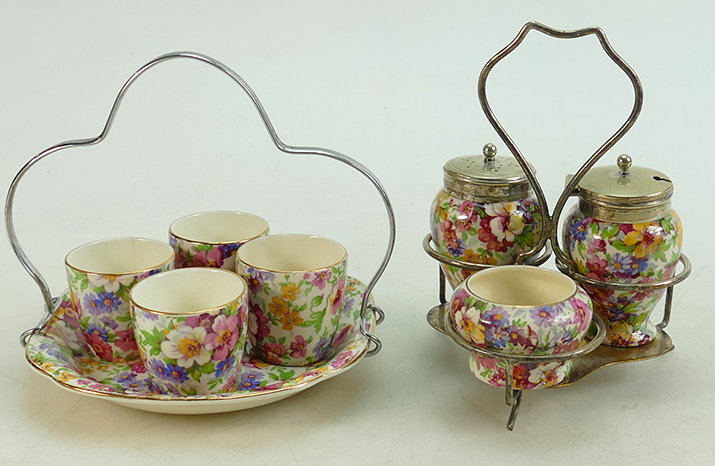
Lot 55 in our March auction is an Egg cup set on a tray and a metal framed condiment set by James Kent Chintz Du Barry Fenton Pottery
We are taking the opportunity to talk about Chintz Pottery at auction in this article. In our upcoming auction on 14 March, we have lots of Chintz in many of our auction lots, with some beautiful pieces that aren’t half as scandalous as they were once considered when they were banned in England back in 1720!

Lot 46 is a delightful group of graduated cheese dishes, dimension of the largest 21 x 18cm by James Kent Du Barry

Lot 48 in our 14 March 2020 auction is a Pate dish and 2 butter dishes, dimensions of largest 15.5cm x 11cm
Chintz pottery describes chinaware and ceramics decorated in an all-over dense floral pattern. And who would have thought that something so innocuous as a floral pattern was once banned in England?
During the late 17th century chintz patterned fabrics became extremely popular and English mills grew concerned, as they did not know how to make chintz. So in 1720 England’s Parliament enacted a law that forbade “the Use and Warings in Apparel of imported chintz, and also its use or Wear in or about any Bed, Chair, Cushion or other Household furniture”.
A few years later the ban was lifted and pottery manufacturers decided to try Chintz pottery production. It was manufactured using a form of transferware where the pattern is applied by transfer printing as opposed to the more traditional method of painting by hand.
The main firms manufacturing chintzware were English and nearly all part of the huge Staffordshire pottery industry. Some of the main manufacturers were Grimwades trading as Royal Winton, A.G. Richardson & Co. trading as Crown Ducal, James Kent, Shelley, and Elijah Cotton trading as Lord Nelson. They turned out a great variety of chintz dinnerware, teaware, and ornamental pieces mostly from the 1920’s up until the 1960’s.
With many different patterns in many colour variations chintz was more commonly made in pottery although some manufacturers such as Shelley produced bone china chintzware, particularly after the Second World War.

Shown here is a fine collection of James Kent Chintz Du Barry Fenton Pottery items that includes: Marmalade pot, 2 squat lidded pots, small vase and shaving mug, height of largest 12.5cm. Grouped together into lot 56 in our March sale
It wasn’t only the English market that enjoyed a chintz craze, chintzware was also copied at the time by German, Czech and Japanese manufacturers.
Royal Winton began reproducing a few of their earlier chintz patterns in the mid-to-late 1990’s and more recently Cath Kidston and Emma Bridgewater have continued the trend for floral.

Lot 85. A fine coffee pot, milk jug, sugar bowl x 2 and cake plate. Height of tallest item is 21cm.
Coming up in the March Auction we have the largest collection of James Kent Dubarry patterned chintz pottery we have ever seen!
All of the pictures featured in this article are of lots from James Kent Dubarry to give you a taste of the treat that is in store for people who’ll be taking part in the sale next month.
James Kent founded Old Foley pottery in 1897 with five men from the firm Barker & Kent, including Arnold Bennett’s brother Septimus. He was later joined in the business by his four sons and the company went limited in 1913.
The use of the name Old Foley derived from the tiny district called Foley situated between the two towns of Fenton and Longton in Stoke on Trent. James Kent also used the names Fenton and Longton on backstamps from time to time.
James died in 1953 and was succeeded by his second son Phillip who continued the family business until 1981 when the German pharmaceutical Bayer Ltd purchased the company. Only for it to be taken over again in 1985 by Morris Rushton and later became part of County Potteries PLC.

Lot 87 in our auction features James Kent Chintz Du Barry Fenton Pottery items to include: Coffee pot, milk, sugar and sandwich plate, height of tallest 21cm.
County Potteries also owned Carlton Ware and in 1989 the company renamed itself Carlton & Kent but it was short lived as later that same year the company went into receivership and the James Kent brand was purchased by Hadida Fine Bone China.
Wedgwood sold the Foley China Works buildings to James Kent in 1995 who were operating from the next door Old Foley Pottery. James Kent continued in Foley China Works after The Old Foley Pottery was demolished in 2006 until its closure in 2008.
The Foley China Works building was demolished in 2010 but thanks to the enthusiasm and tenacity of collectors we still get to see large impressive collections such as the one we have up for auction in the March Antiques and Fine Art Auction.

Shown here left and right are lots 49 & 97. The items in the picture on the left show vinegar pots (Old Foley backstamp) x 2 , a lidded pot and incomplete egg cup set. The vase pictured to the right is part of a larger lot that will include: Cake plate, shallow bowl, side plates x 6, finger bowls x 6 and small vase, diameter of largest 29cm.
Selling Chintz at Auction
If you have chintz pieces you’re looking to sell, their pieces consistently perform well at auction and our staff is well-placed to provide valuations and advice on selling your items. Call 01782 638100 or emailenquiries@potteriesauctions.com to book a valuation appointment to attend one of our Tuesday valuation days. We also provide valuations via WhatsApp, simply send some clear photographs of your items via the app to 07864 667940. Additionally, we can send you links to our catalogues via WhatsApp–message the above number via the app and ask to receive our catalogues. Make sure you are subscribed to our email newsletters, too!
